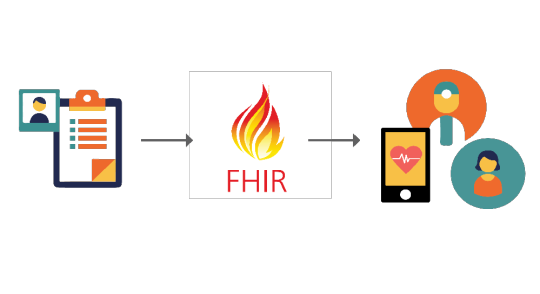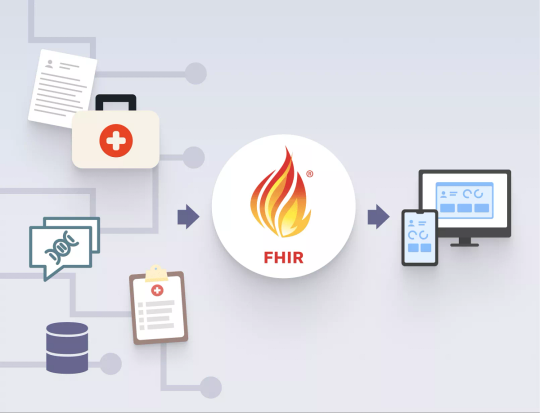At Firely, we believe that better healthcare starts with accessible, interoperable data. As pioneers in the healthcare data space, we focus on simplifying the global adoption of FHIR (Fast Healthcare Interoperability Resources), a revolutionary standard that enables seamless sharing of healthcare data. Our mission is to make healthcare data flow freely, enabling organizations to deliver more efficient, connected, and patient-centered care.
Don't wanna be here? Send us removal request.
Text
How FHIR is Revolutionizing Healthcare Interoperability 🚀🏥

In the evolving world of healthcare, the ability to exchange data seamlessly is crucial for improving patient outcomes and operational efficiency. One of the most impactful advancements in healthcare data exchange is the FHIR (Fast Healthcare Interoperability Resources) standard.
By enabling healthcare systems to share data more efficiently and securely, FHIR healthcare is paving the way for better care coordination and smarter decision-making. Platforms like Firely are helping organizations adopt FHIR and unlock its potential to enhance healthcare interoperability. In this blog, we will explore how FHIR is transforming the healthcare industry and why it’s becoming a vital tool in improving patient care.
What is FHIR Healthcare? 🤔
FHIR healthcare refers to the use of the FHIR standard in healthcare systems to facilitate the exchange of health information. Developed by HL7 (Health Level Seven International), FHIR is an open standard designed to simplify the process of exchanging electronic health data across various systems and platforms. It uses modern web technologies, including HTTP, RESTful APIs, and JSON or XML data formats, to ensure that health information can be shared in real time, across different healthcare providers and organizations.
Unlike older standards, which were rigid and difficult to implement, FHIR is designed to be flexible and scalable, making it easy to integrate into existing healthcare systems. The standard defines a set of FHIR resources, which are individual pieces of healthcare data, such as patient records, laboratory results, medications, and allergies. These resources can be exchanged independently or together, depending on the needs of the healthcare system.
The key objective of FHIR healthcare is to promote interoperability. In healthcare, interoperability is the ability of different systems to communicate with each other and share data effectively. FHIR makes this possible by providing a standardized way for healthcare systems to exchange information, ensuring that data is accurate, timely, and available when needed.
How FHIR Healthcare Improves Patient Care 🏥💡
The adoption of FHIR healthcare offers numerous benefits for both healthcare providers and patients. Here are some of the key ways FHIR is improving patient care:

Faster and More Efficient Data Exchange: Traditionally, healthcare data was often trapped in silos, making it difficult for providers to access the information they needed. With FHIR, patient data is shared in real time, allowing healthcare providers to access up-to-date information quickly. This leads to faster decision-making, reducing delays in care and improving clinical outcomes.
Better Care Coordination: In the past, patients often had to repeat tests or provide the same information to multiple healthcare providers because data was not easily shared. FHIR eliminates this issue by enabling providers to access a comprehensive view of a patient's medical history, including medications, allergies, lab results, and diagnoses. This results in better care coordination, especially for patients with chronic conditions or those receiving care from multiple providers.
Improved Patient Safety: One of the critical issues in healthcare is ensuring that patients are not exposed to unnecessary risks, such as medication errors or duplicate tests. With FHIR, healthcare providers have access to accurate, real-time information about a patient’s current medications, lab results, and medical history. This reduces the risk of errors and ensures that patients receive the appropriate care at the right time.
Patient-Centered Care: FHIR facilitates the use of electronic health records (EHRs) and other health technologies that place the patient at the center of their own care. With FHIR-enabled systems, patients can access their health data, share it with providers, and make informed decisions about their care. This empowers patients and improves their overall experience in the healthcare system.
The Role of Firely in FHIR Healthcare 🌐🔧
For healthcare organizations looking to implement FHIR healthcare, platforms like Firely are invaluable. Firely offers a range of solutions and tools that simplify the adoption of FHIR and ensure that healthcare organizations can fully leverage its capabilities.
Firely provides resources for building, testing, and deploying FHIR-based systems, making it easier for healthcare providers to integrate FHIR standards into their existing infrastructure. From FHIR API development to data validation and compliance support, Firely’s tools help streamline the implementation process and ensure that healthcare organizations remain compliant with regulatory requirements.
One of the standout features of Firely is its FHIR server, which is designed to store and manage FHIR resources, making it easy to retrieve and exchange healthcare data. With Firely’s FHIR server, healthcare organizations can manage large volumes of patient data securely and efficiently. This allows for seamless interoperability, which is essential for improving patient care and operational efficiency.
Firely’s tools also make it easier for developers to build FHIR-compliant applications, ensuring that they can integrate healthcare data in a standardized and secure way. Whether it’s for creating mobile health apps, telemedicine platforms, or clinical decision support systems, Firely provides the resources needed to develop FHIR-powered solutions.
Key Benefits of FHIR Healthcare 🚀
FHIR healthcare offers several advantages that benefit both healthcare providers and patients. Let’s take a closer look at some of the key benefits:
Simplified Integration: FHIR is designed to be easy to implement and integrate into existing healthcare systems. Its use of modern web technologies, such as APIs and JSON, makes it simple for developers to work with and integrate into their applications.
Cost Savings: By reducing the complexity of data exchange and eliminating the need for custom integrations, FHIR helps healthcare organizations save on costs. Additionally, it reduces the time spent on manual data entry, which increases overall productivity.
Interoperability: FHIR is specifically designed to promote interoperability between different healthcare systems, which is essential for improving care coordination and patient outcomes. By enabling the exchange of accurate and timely data, FHIR ensures that healthcare providers have the information they need to make informed decisions.
Security and Compliance: Security is a top priority in healthcare, and FHIR includes built-in security features to ensure that patient data is protected. FHIR supports encryption, authentication, and authorization protocols, ensuring that healthcare organizations can comply with privacy regulations such as HIPAA.
Scalability: FHIR is scalable and can be used by healthcare organizations of all sizes. Whether you’re a small clinic or a large hospital network, FHIR can be implemented to suit your needs and grow with your organization as it expands.

Overcoming Challenges in FHIR Healthcare ⚠️
While FHIR healthcare offers numerous benefits, its adoption can present challenges. One of the main challenges is transitioning from legacy systems that do not support FHIR to modern FHIR-compliant systems. This can require significant time and investment, especially for larger organizations with complex IT infrastructures.
Additionally, healthcare organizations must ensure that their FHIR implementations are secure and comply with regulatory requirements. This requires careful planning and coordination, as well as ongoing monitoring and updates to ensure that systems remain compliant with evolving standards and regulations.
The Future of FHIR Healthcare 🌟
The future of FHIR healthcare is bright, with continued advancements in the standard and its adoption across the healthcare industry. As more organizations implement FHIR, the benefits of improved care coordination, patient safety, and data interoperability will become even more pronounced. Future developments in FHIR will likely include new resources, enhanced security features, and deeper integration with emerging technologies, such as artificial intelligence (AI) and machine learning (ML), to further improve patient care and healthcare outcomes.
Conclusion 🎯
For more information, check out this link. FHIR healthcare is a transformative force in the healthcare industry, making it easier for organizations to share data, improve care coordination, and provide better patient outcomes. Platforms like Firely play a crucial role in simplifying the adoption of FHIR, providing the tools and resources necessary to implement this powerful standard. As healthcare continues to evolve, the role of FHIR in ensuring interoperability and improving patient care will only grow. Embracing FHIR healthcare is essential for healthcare organizations looking to stay ahead in a rapidly changing digital landscape.
1 note
·
View note